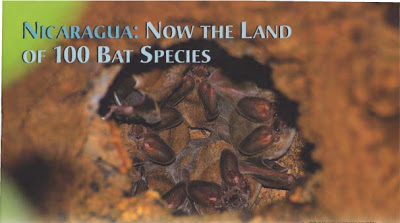Carol L. Chambers, Professor of Wildlife Ecology at Northern Arizona University, has an article about the bat survey she did with us in the new Bats magazine.
The Paso del Istmo is a narrow strip of low mountains sand-wiched between Lake Nicaragua and the Pacific Ocean. This isthmus is only 12 miles (19 kilometers) wide, but it is a critical passageway for wildlife migrating between North and South America or moving locally among forests of Central America.
And it contains an important tract of tropical dry forest – one of the most endangered forest ecosystems in the world. This forest is rapidly being replaced by croplands of beans or rice or by non-native commercial trees such as teak. Surviving old growth is often reduced to isolated patches, with dire consequences for forests and wildlife. My colleagues and I came to Nicaragua to study how forest fragmentation impacts bat communities. That research continues, but we’ve already made some exciting discoveries.
I had visited this area previously with Suzanne Hagell, a former graduate student at Northern Arizona University. Using genetic analysis, she discovered that black-handed spider monkeys (Ateles geojfroyi) were significantly inbred, largely because of their limited ability to move among the few large, disconnected forest patches remaining on this landscape. Bats, however, are more mobile than monkeys so their genetic diversity may be less affected by forest fragmentation.
So instead of collecting DNA as Suzanne did, I “captured” the bat community using mist nets to intercept bats flying along forest corridors and bat detectors to capture their echolocation calls in forest patches of different sizes and levels of isolation. Bat Conservation International and the Percy Sladen Memorial Fund helped fund this project and the U.S. Bureau of Land Management loaned us the Anabat detectors.
…
I spent December 2011 and January 2012 in the Paso del Istmo. Paso Pacifico, a Nicaraguan organization run by women dedicated to restoring and conserving ecosystems of Central America’s Pacific slope, helped me locate a field station, guides and landowners willing to collaborate. We set nets across shal-low streams and rivers and quickly began capturing bats.
Sixteen colleagues and friends from the United States and Canada helped with the mist-netting. Nicaragua’s premier bat biologist, Arnulfo Ramon Medina Fitoria, also joined us. He taught me how to distinguish especially tricky species, such as those in the genus Carollia, that are identified by the shape and size of their incisors or color-banding patterns of their fur.
Biology students Jose Gabriel Martinez Fonseca and Marlon Francisco Chaves Velasques of the Universidad Nacional Aut6noma de Nicaragua became our acoustic specialists. After on-site training by Chris Corben, designer of the Anabar, and Kim Livengood of Titley Electronics, Martinez and Chaves de- ployed bat detectors, rotating them weekly among more than 100 forest patches from January to May.
…
By January 26, just five days before I was due to return to the United States, we had “bagged” 40 ofNicaragua’s 99 known bat species. On our 34″‘ night of netting, we felt that we had thoroughly de- scribed the bat community in our study area. On this night, our nets across a stream and along forest paths were snagging dozens of bats per hour and had even added two new species to our count.
Then I removed a large bat from one of our nets. The bat’s wing tips looked bleached white, and I wondered if the bat had an injury. I took it to the processing table and, to my great surprise, our field guides showed it to be a pale-faced bat (Phylloderma stenops). And our already-exciting evening became absolutely thrilling.
Arnulfo pointed to the goose bumps on his arms. Although he spoke only Spanish and I only English, I was beginning to understand that this large bat in my hands, with her short brown fur and long gray wings, was, in fact, the most amazing capture of our two months of mist-netting. In Fiona Reid’s Mammals of Central America and Southeast Mexico, the range map for this rare, forest-dwelling species showed only a question mark for Nicaragua. We had established the first record in the country of the pale-faced bat, a species Arnulfo had been hoping to capture for 11 years. As Arnulfo held her gently, we took pictures, documented her white wing tips and a small gland under her throat, then released her.
That wonderful addition and yet another new capture later that night (the hairy big-eyed bat, Chiroderma villosum) brought our species count for the project to 44. And it increased the confirmed number of bat species in Nicaragua to exactly 100. I didn’t even care that during our next – and last – night of netting, more than 60 percent of our captures were Jamaican fruit-eating bats that shredded my handling glove.
